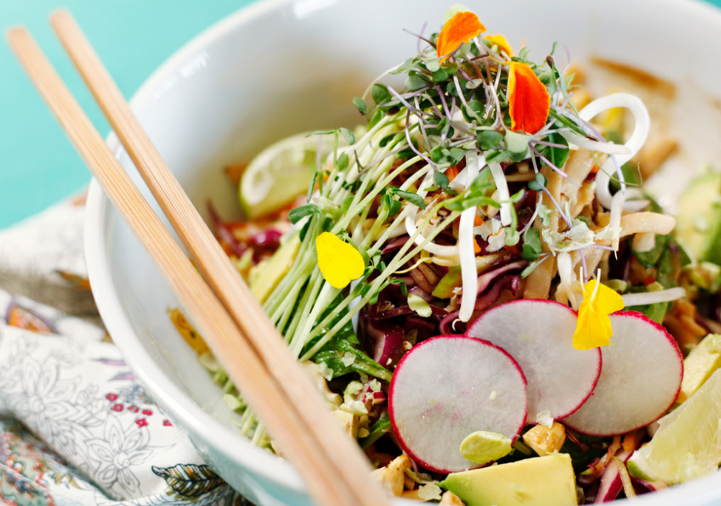How Protein Helps Your Body
Aug 15, 2024

This powerful nutrient builds muscle, fights illness and more.
Advice on losing weight, building muscle or maintaining a healthy diet usually comes with this claim: Eat plenty of protein. But it can be difficult to know just how to do that. The good news is, getting adequate protein in your diet doesn’t mean you have to prepare complex meals or eat meat morning, noon and night. In fact, you can find protein in a variety of foods that are tasty and easy to make. Let’s take a look at what protein does for the body and how to easily get the right amount in your diet.
What Does Protein Do?
Protein is a fundamental component in helping your organs function properly, promoting healing and making your body strong. Protein is made up of groups of molecules called amino acids, which link together in chains. They work at the cellular level to create who you are, from giving your organs and muscles structure to making up your skin and hair. Protein also plays several important roles in your overall health. Here are a few examples of how protein works in your body:
- It helps you feel full: Protein takes longer to digest than carbohydrates, which may help you feel satiated longer and keep you from overeating.
- It strengthens bones: Research has shown that protein can help maintain bone mass and reduce the risk of fractures.
- It builds and repairs muscle: If your exercise routine incorporates weight training or lifting, getting plenty of protein can help you build muscle mass. Protein also contributes to muscle repair after strenuous exercise.
- It helps you fight illness: Proteins are instrumental in forming antibodies, which fight off bacteria and viruses. When you are sick, eating plenty of protein can help you bounce back sooner — and prevent illness the next time you encounter that virus or bacterium.
- It can keep your heart healthy: Studies indicate that a protein-rich diet can lower blood pressure and “bad” cholesterol levels, which in turn can reduce the risk of heart disease.
Read More: Learn About Protein from Our Registered Dietitians
How to Get Enough Protein
Proteins have 20 amino acids, but our bodies make only 11 of these naturally, so we need to consume protein to get our fill. The best way is through protein-rich whole-food sources, including meat, dairy, nuts, seeds and legumes. The amount of protein your body needs depends on your sex, weight and lifestyle factors, such as how much exercise you typically get. The U.S. Department of Agriculture recommends that the average adult get 5 to 7 ounces of protein foods each day, based on daily calorie intake. In terms of grams, aim for at least 0.8 grams of protein for each kilogram of body weight. That means an average adult who weighs 165 pounds, or 75 kilograms, should eat 60 grams of protein per day. Women who are pregnant or breastfeeding should have slightly more protein than normal to support the baby’s development and their milk supply.
An ounce of protein varies by food source — read on for examples — but the good news is that most people don’t need to closely track their protein intake or weigh and measure food before they eat it. Simply eating a well-balanced diet with protein-rich food sources in every meal should ensure that you are within the optimal range.
Read More: Decoding Food Labels for a Healthier You
Animal-Based Protein Sources
Meat, fish, dairy and eggs are dense sources of protein, meaning a little goes a long way. If you eat meat and dairy, these foods can provide your body with protein:
- Meat and seafood: Go for chicken, lamb, and lean beef or pork. Fish, such as salmon and tilapia, is also an excellent source of protein. For meat and fish, a portion about the size of a deck of cards equates to 3 ounces of protein.
- Eggs: One whole large egg, 1½ egg whites or 3 tablespoons of a liquid egg-white product is equal to a 1-ounce serving of protein.
- Dairy: Try mixing up a smoothie using Greek yogurt (which has nearly twice as much protein as regular yogurt) or cottage cheese. For a protein-rich snack, opt for whole-grain crackers and cheese. For hard cheeses, a ⅓-cup serving has about 1 ounce of protein, while the same portion for soft cheeses equals about 2 ounces.
Plant-Based Protein Sources
While animal-based products provide a lot of protein, it’s important to strike a balance between meat and plant-based foods such as nuts, seeds, beans and soy products, which are nutrient-dense. Most Americans are getting more than their recommended daily intake of meat, though only about half are meeting guidelines for plant-based protein sources.
- Nuts and seeds: These have proteins and healthy fats. Snack on a handful of almonds, pistachios, walnuts, pumpkin seeds or sunflower seeds. Or pair a tablespoon of almond, cashew, peanut or sunflower butter with some fruit or nondairy yogurt.
- Legumes: Beans, peas and lentils are packed with protein — include ¼ cup of your favorite variety to get 1 ounce of protein. You can also get 1 ounce of protein from about ⅓ cup of hummus or one falafel patty, both of which are made with chickpeas.
- Soy products: Also a legume, soybeans (and foods derived from them) are a good source of protein. Try ¼ cup of soybeans or tofu, or 1 ounce of cooked tempeh.
- Nondairy alternatives: If you are vegan, soy-based milk and yogurt alternatives are a great option; in fact, a 2022 study found that soy-based drinks had slightly more protein than cow’s milk. Almond and cashew milk alternatives offer about a third as much protein as soy and cow’s milk.
How Much Protein Is Too Much?
As with all things, protein should be consumed in moderation. Experts are still weighing whether there is such a thing as too much protein, but there are some risks to keep in mind. Eating too much animal-based protein can raise your cholesterol levels — and your heart disease risk — and put strain on your kidneys, liver and bones, for example. The average person’s daily intake of animal-based protein is unlikely to do harm, though, so simply aim for a well-rounded diet that nourishes your body.


